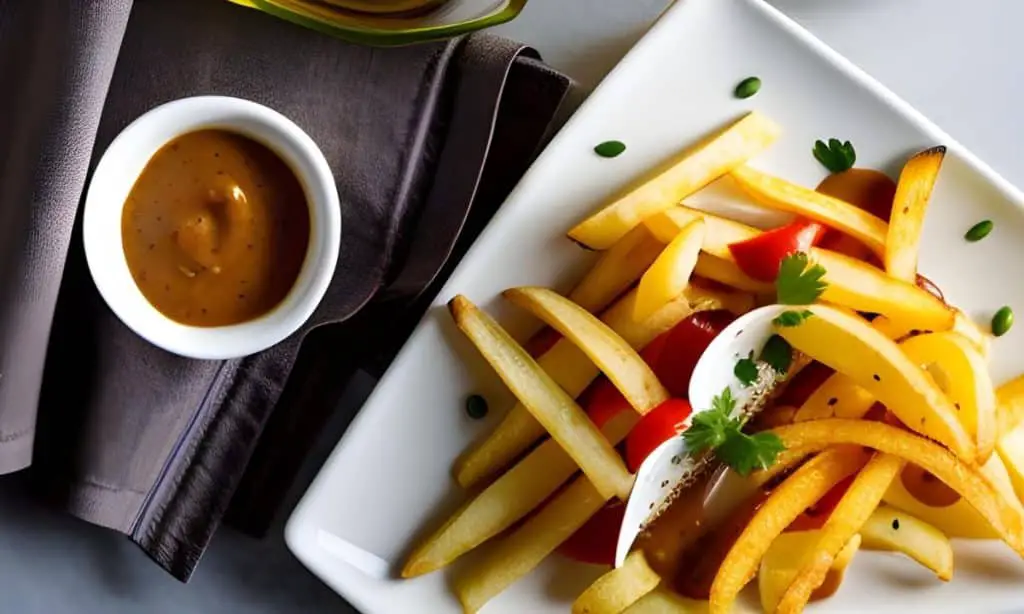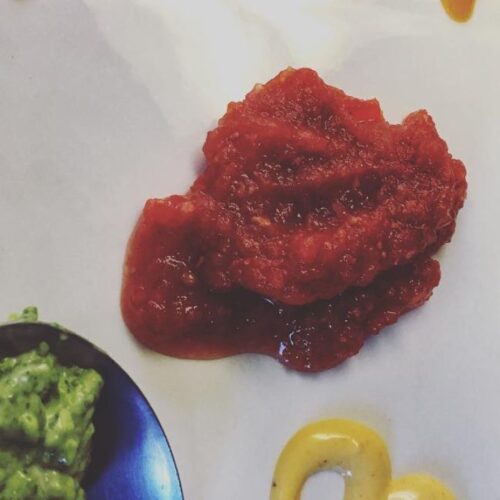Are you ready to spice up your favorite meals? You need homemade bistro sauce! Bistro sauce is creamy, zesty, and herb-infused.
Imagine biting into a delicious burger topped with caramelized onions, crispy bacon, and homemade bistro sauce.
Or dipping golden, crispy fries into a garlicky, shallot-filled sauce. Appetite-inducing, right? That’s the start! Bistro sauce may improve your dishes in many ways.
Bistro sauces vary. Store bought sauce can be bland, preservative-laden, and lacking in flavor. I’ll show you how to make bistro sauce from scratch. You’ll never buy store-bought again after trying our homemade version!
How to Make Bistro Sauce
I’ve hosted countless family and friend dinners. My homemade bistro sauce always steals the show!
It’s always a conversation starter and has garnered many comments and recipe requests.
It awakens taste buds and unites people. I can say that making bistro sauce will impress your guests and improve your cooking skills!
Enough talking let’s cook! My easy-to-follow bistro sauce recipe, FAQs, and serving suggestions are below. Put on your apron, polish your knives, and let’s make bistro sauce!
Bistro Sauce Ingredients
- 1 cup of mayonnaise: You can use store-bought mayonnaise or make your own from scratch if you’re feeling adventurous.
- 2 tablespoons of Dijon mustard: Dijon mustard is a key ingredient in bistro sauce, providing its characteristic tangy flavor.
- 1 tablespoon of white vinegar: Vinegar adds acidity to the sauce and helps balance the flavors.
- 1 tablespoon of freshly squeezed lemon juice: Lemon juice adds brightness and freshness to the sauce.
- 2 tablespoons of fresh herbs: Choose a combination of parsley, chervil, tarragon, and chives, finely chopped.
- 1 small shallot, minced: Shallots add a mild oniony flavor to the sauce.
- 1 clove of garlic, minced: Garlic adds a subtle kick to the sauce.
- Salt and pepper to taste: Season the sauce with salt and pepper according to your preference.
Crafting Homemade Bistro Sauce – Step by Step
Mix the Ingredients
In a medium-sized mixing bowl, combine the mayonnaise, Dijon mustard, white wine vinegar, and freshly squeezed lemon juice.
Stir until the ingredients are well combined and you have a smooth base for your bistro sauce.
Next, add in the minced shallot, minced garlic, and the freshly chopped herbs of your choice.
These herbs are what give bistro sauce its distinct flavor, so feel free to adjust the quantities to suit your taste preferences.
Mix everything together thoroughly, ensuring that the herbs and aromatics are evenly distributed throughout the sauce.
Now it’s time to season your bistro sauce with salt and pepper. Start with a small amount of salt and pepper, and then taste as you go.
You can always add more if needed. Remember, it’s easier to add more seasoning gradually than to fix an overly salty or peppery sauce, so take your time and adjust to your liking.
Let the Flavors Mingle
Once you’ve mixed all the ingredients together and seasoned them to perfection, cover your bistro sauce and refrigerate it for at least 30 minutes to an hour.
This allows the flavors to meld together and develop, resulting in a more robust and flavorful sauce.
The resting time also helps to thicken the sauce slightly, giving it a perfectly creamy consistency.
During this time, you can prepare the dishes you’ll be serving with your bistro sauce.
Whether it’s a juicy burger, a refreshing salad, or a platter of crispy seafood, bistro sauce can enhance the flavors of many different foods.
Its versatility is one of the reasons why it’s a beloved condiment in French cuisine and beyond.
Serve and Enjoy!
After resting time, your homemade bistro sauce is ready to be enjoyed! Give it a final taste test and adjust the seasoning if needed.
When you’re satisfied with the flavor, take it out of the refrigerator and bring it to room temperature for a few minutes before serving.
Bistro Sauce Variations
Classic Bistro Sauce
Mayonnaise, Dijon mustard, garlic, shallots, fresh herbs like chives, tarragon, and parsley, and vinegar or lemon juice make up bistro sauce.
Its creamy, tangy, and herbaceous flavor complements burgers, sandwiches, fries, and grilled meats.
Spicy Bistro Sauce
Bistro sauce can be spiced if you want to heat it. Hot sauce, sriracha, and red pepper flakes can spice up your sauce.
Create a spicy bistro sauce that enhances your dishes by adjusting the spiciness.
Lemon-Dill Bistro Sauce
Bistro sauce can be refreshed with fresh lemon juice and dill. The sauce is ideal for shellfish or grilled vegetables due to its freshness from lemon and dill.
Smoky Bistro Sauce
You can Smoke your bistro sauce if you like it. Adding smoked paprika, chipotle powder, or liquid smoke to your sauce does this. The sauce’s smokey flavor complements grilled or roasted meats.
Roasted Garlic Bistro Sauce
Roasted garlic enhances bistro sauces with its sweet, caramelized flavor. Mash roasted garlic cloves into your sauce. Roasted garlic adds richness to the rich bistro sauce.
Horseradish Bistro Sauce
Horseradish adds acidity to bistro sauce. Roasted meats, charcuterie boards, and sandwiches taste great with horseradish. Horseradish is potent, so adjust to taste.
Mediterranean Bistro Sauce
Sun-dried tomatoes, Kalamata olives, and capers give bistro sauce a Mediterranean flavor. This sauce is ideal for Mediterranean meals like falafel, kebabs, and wraps since it has umami and tanginess.
Using Bistro Sauce in Cooking
I experiment with tastes and use bistro sauce in several ways. Here are some inventive ways I use this versatile spice to add flavor to various recipes.
Bistro sauce is a great substitute for ketchup and mustard. Its creamy texture and tangy taste elevate my homemade burgers, grilled chicken sandwiches, and vegetarian wraps. Bistro sauce on the bun or bread enhances the flavor.

Bistro sauce enhances grilled meats and seafood. I love dipping chicken, steak, and shrimp skewers in it. I brush it on meat or seafood during the last few minutes of cooking to make a sour, creamy glaze. It adds flavor to grilled meals easily.
Bistro sauce makes a creamy salad dressing. I blend it with more vinegar or lemon juice to make a tart dressing for mixed greens, roasted vegetables, or pasta salads. It makes a tasty grain salad when mixed with cooked quinoa or couscous.
Bistro sauce works great on roasted veggies, which are a mainstay in my cuisine. I add a teaspoon of bistro sauce to roasted carrots, broccoli, and cauliflower for a tangy and creamy coating. It enhances the roasted veggies’ taste.
Bistro sauce can be used to flavor meats and seafood. Before grilling or baking, I mix bistro sauce with olive oil, herbs, and spices and marinate chicken, beef, or fish for a few hours. The dish is creamy, zesty, and moist.
Bistro sauce is great on wraps and tacos. I put it over the tortilla or wrap before adding my favorite fillings, like grilled chicken, roasted veggies, or black beans. The creamy and tangy bistro sauce balances the other components for a wonderful taste.
FAQs About Bistro Sauce
What does bistro sauce taste like?
Bistro sauce has a unique flavor profile that can be described as tangy, creamy, and savory. It typically has a rich and velvety texture with a hint of acidity and a touch of sweetness. The tanginess comes from ingredients like vinegar or lemon juice, while the creaminess comes from mayonnaise, sour cream, or yogurt.
Can I make bistro sauce ahead of time?
Yes, Bistro sauce actually benefits from resting in the refrigerator for at least 30 minutes to an hour to allow the flavors to meld together. You can even make it a day or two in advance and store it in an airtight container in the refrigerator for maximum flavor development.
Can I use different herbs in my bistro sauce?
Yes, you can! The beauty of homemade bistro sauce is that you can customize it to suit your taste preferences. While parsley, chervil, tarragon, and chives are traditional herbs used in bistro sauce, you can experiment with other herbs like cilantro, basil, or dill to create your own unique flavor profile.
Can I substitute mayonnaise with another base?
Mayonnaise is a key ingredient in bistro sauce as it provides a creamy base. However, if you’re looking for a lighter alternative, you can use Greek yogurt or sour cream instead of mayonnaise. Just keep in mind that it may alter the taste and consistency of the sauce.
How long can I store homemade bistro sauce?
Homemade bistro sauce can be stored in an airtight container in the refrigerator for up to 5-7 days.
Can I freeze bistro sauce?
It’s not recommended to freeze bistro sauce as mayonnaise and yogurt-based sauces can separate and become watery upon thawing. And, the herbs in the sauce may lose their freshness and flavor after being frozen. It’s best to enjoy bistro sauce fresh and store any leftovers in the refrigerator for up to a week.

Bistro Sauce Recipe
Ingredients
- 1 cup of mayonnaise
- 2 tablespoons of Dijon mustard
- 1 tablespoon of white vinegar
- 1 tablespoon of freshly squeezed lemon juice
- 2 tablespoons of fresh herbs
- 1 small shallot minced
- 1 clove of garlic minced
- Salt and pepper to taste
Instructions
- In a medium bowl, whisk together the mayonnaise, sour cream, and Dijon mustard until well combined.
- Add in the chopped fresh parsley, chives, tarragon (if using), capers, vinegar or lemon juice, and minced garlic. Stir to combine.
- Taste the sauce and season with salt and pepper to your liking. Adjust the flavors as desired, adding more herbs, mustard, or vinegar/lemon juice to suit your taste.
- Transfer the bistro sauce to a jar or container and refrigerate for at least 30 minutes to allow the flavors to meld together.
- Serve chilled and use as a condiment or dipping sauce with your favorite dishes, such as burgers, sandwiches, grilled meats, seafood, salads, and more.





